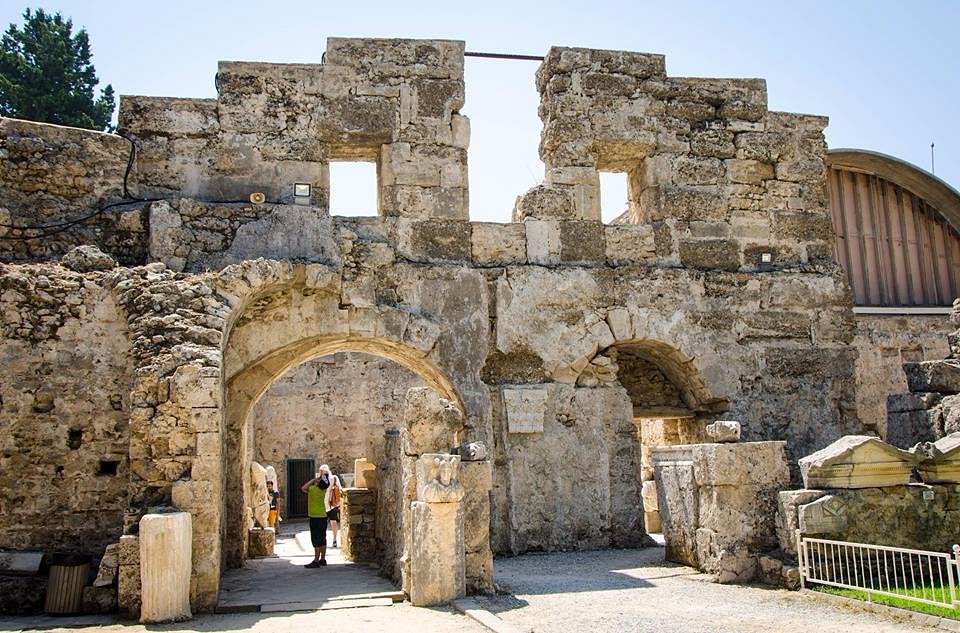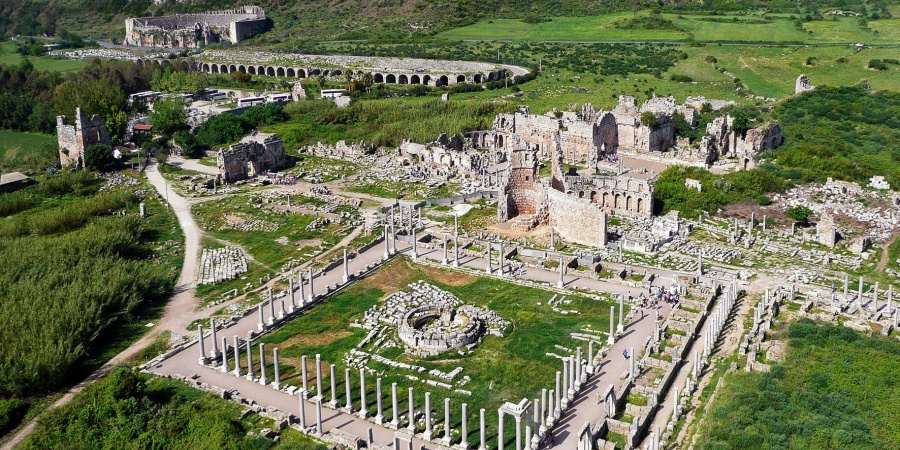Excursion 1
(Side Open Air Museum Tour)

Side ancient city is renowned as an open-air museum that showcases the rich history and cultural heritage of various ancient civilizations. Located in the Side region, it attracts visitors with its fascinating historical artifacts and stunning archaeological remains, offering a glimpse into its millennia-old past.
The ruins of Side Ancient City predominantly reflect remnants from the Roman and Byzantine periods. Visitors today can explore various structures such as the city walls and gates, basilicas, commercial agora, the Agora Bathhouse (currently used as Side Museum), the Bishop's Palace, Victory Monument, Vespasian Fountain, Nympahaeum monumental fountain, Ancient Theater, and the temples of Apollo and Athena. Exploring these ruins is free of charge, with the exception of entrance fees for the Ancient Theater and the museum.
The Ancient Theater of Side stands majestically in the center of the ancient city, welcoming visitors with its grandeur. Built in the 2nd century AD, it holds the distinction of being Anatolia's largest ancient theater, boasting a three-story stage building and a seating capacity of 17,000. Architecturally resembling the Roman Colosseum, this theater served not only as a venue for theatrical performances during the Roman era but also doubled as an arena for gladiatorial contests and fights with wild animals.
The Nymphaeum monumental fountain, built in the 2nd century AD, holds the distinction of being the largest and most magnificent fountain from antiquity in Anatolia.
In the southern part of the Side peninsula, east of the harbor, are the ruins of the temples dedicated to Athena and Apollo, the two great gods of the city. These temples date back to the 2nd century AD. Some of the columns of the temple have been restored and placed back in their original positions. Besides these columns, sitting on the stones and watching the sunset is a must-do activity for everyone visiting this beautiful town on vacation. These temples are iconic symbols of Side.
Excursion 2
(Perge-Aspendos Ancient City)

Antalya is not just about sea, sun, and beaches; it is also a hub of, ancient civilizations, and ruins. Among the most important sites are the ancient city of Perge, and Aspendos Theater. For those interested in history and archaeology, a detailed tour of Aspendos and Perge would be ideal.
Perge is renowned for its well-preserved Hellenistic and Roman structures. Visitors can explore the ancient theater, stadium, main street, bathhouse ruins, Hellenistic towers, and Agora buildings.
Perge, an ancient Greek city, is situated approximately 9 miles east of present-day Antalya in southwestern Anatolia. During the Hellenistic period, Perge was the capital of Pamphylia and one of the four major cities that included Aspendos, Side, and Sillyon.
It was one of the richest and most beautiful cities of the ancient world, renowned especially for its temple dedicated to the beautiful desert goddess Artemis. The city also hosted the famous Greek mathematician Apollonius of Perge and according to legend, was the birthplace of beer.
Perge remained under Greek control for about 450 years until it was conquered by the Persians in 546 BC. Two hundred years later, the armies of Alexander the Great entered Perge, putting an end to Persian rule. From then until the fall of the Roman Empire, Perge was under Roman protection. Exploring its extensive history and the remnants blending three different cultures is a great pleasure.
Aspendos, another major city of Pamphylia, was situated along an important trade route. The armies of Alexander the Great set their sights on the city and eventually conquered it in 333 BC. Aspendos later came under Roman protection and remained so until the end of the Roman Empire in 930 AD.
The theater of Aspendos, built during the reign of Marcus Aurelius between 161-180 AD, is considered one of the best-preserved ancient theaters in the world and is a highly popular tourist attraction. It still hosts opera and ballet performances during the summer months.